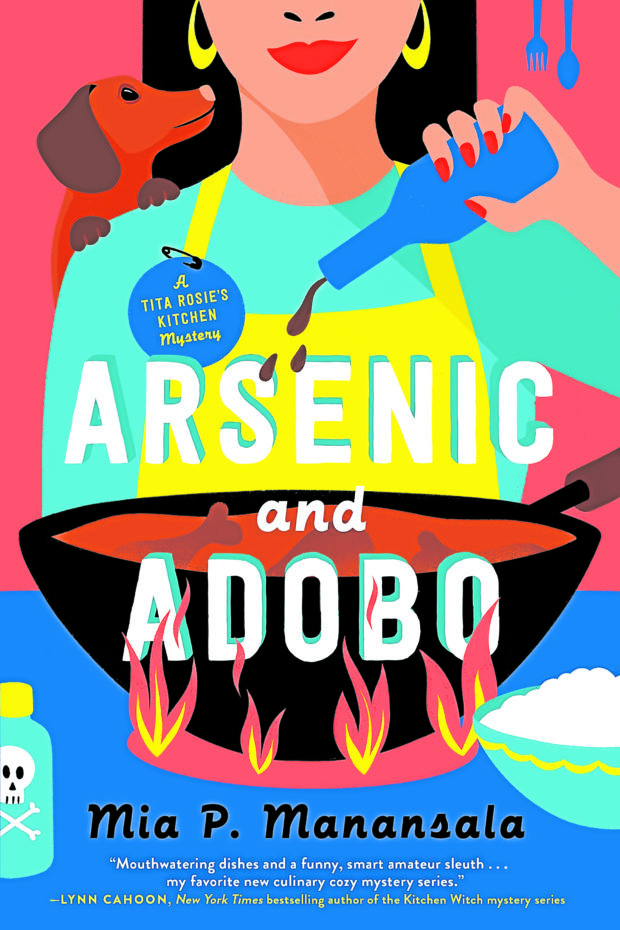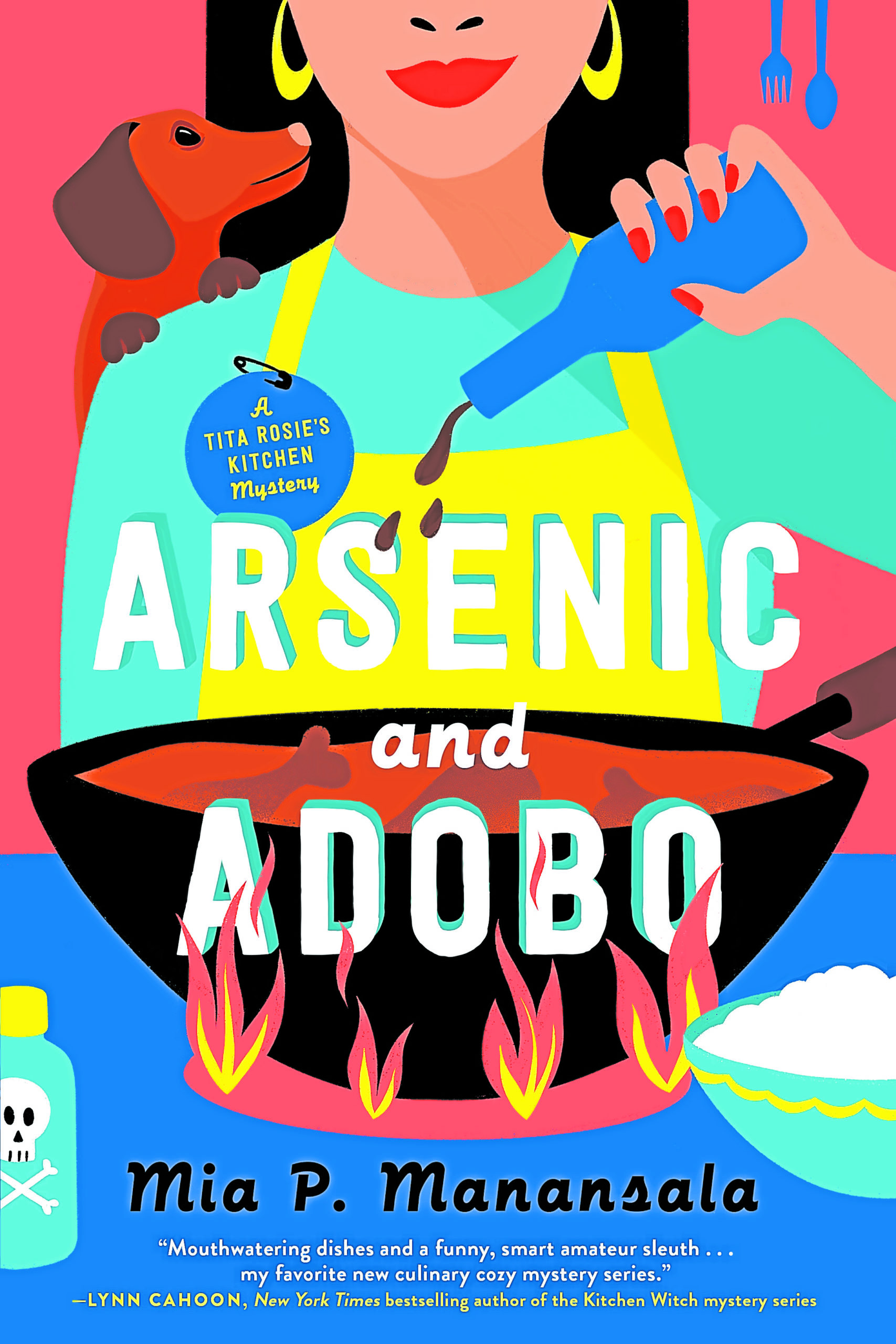
Who knew you could make a merienda of murder and mystery out of a single Pinoy meal?
This is the premise of Filipino American author Mia P. Manansala’s “Arsenic and Adobo” (Berkley Prime Crime, New York, 2021, 316 pages), an utterly charming detective novel with an unusual setting and unusual characters.
Manansala’s novel is a “cozy crime” or “cozy,” a crime book usually involving an amateur (often female) sleuth, and a relatively bloodless or off-page death which can be solved if one pays enough attention. It is an immensely popular subgenre brimming with colorful small towns.
That is exactly the case with “Arsenic and Adobo,” except in this case, it is a Filipino American protagonist. Lila Macapagal, smarting from a breakup in Chicago, returns home to tiny Shady Palms, Illinois, to help save her aunt Tita Rosie’s Filipino restaurant. Once there, she meets ex-boyfriend Derek Winter, who has become a notoriously nasty food vlogger and whose stepfather, Mr. Long, is not only the restaurant’s landlord but wants nothing more than to kick out their establishment.
Yet readers haven’t gotten two chapters into “Arsenic and Adobo” when Derek, served pork and chicken adobo, among other Pinoy dishes, hears these words from Lila: “Oh, come on. Would it kill you to say something nice for a change?” At which point, Derek face-plants into his food—and dies.
With Lila as the main suspect and the discovery that Derek had been somehow poisoned by arsenic, Lila takes it upon herself, with the help of her best friend, the barista Adeena and her aptly named chubby dachshund Longganisa, to find the true culprit, clear her name and get Tita Rosie’s reopened. Manansala just nails Lila, a very likeable protagonist as a snarky, stubborn but sincere 25-year-old.
Manansala is the perfect person to write this book. Born and raised in a Filipino immigrant family in Chicago, in a multigenerational home, she says, “What I know of Filipino culture is based on the way my family operated and my experiences growing up—I unfortunately wasn’t part of a large Filipino community growing up, so everything I’ve learned about our history, language, folklore, etc. are all things I researched on my own as an adult.”
She attended Northeastern University in Chicago and majored in English. While writing, she worked as an English language instructor at an international school before the pandemic shut it down, and she now works part-time at a library and as a book coach.
It took Manansala about a year and a half to finish the book, facing down all the rejections she had received in the past as well as keeping motivated after the death of her father.
“The book is dedicated to my dad, who passed away at the end of 2018,” she explains. “He taught me everything I know about food in general, and Filipino food especially. He was the cook in the house, and it was from him that I learned how food can be someone’s love language.”
“Arsenic and Adobo” is as immensely colorful as every dish, not just the Filipino ones. With the story told in first person, readers will get to guess the killer and the reason from Lila’s perspective. Can you guess before she does? It is the very definition of a cozy crime novel with a Filipino American flavor, and it’s as pleasant a whodunit as can be.
It is the first of the “Tita Rosie’s Kitchen Mystery” series, from Manansala’s three-book deal with her publisher. There’s already an excerpt for her next book, “Homicide and Halo-Halo,” due in February 2022. The third book will be out in November of that year.
“Arsenic and Adobo” also exemplifies the value of Filipino American representation in new genres of literature. “Anything else, I’m not allowed to talk about since they’re not official or announced yet, but I’m hoping by the end of the year I can share some very exciting news with you all!”
“Arsenic and Adobo” is seasoned thoroughly with Filipino culture from the relationships to the names and the food, of course. It features a glossary for the Filipino terms and recipes for everything from Lila’s Ube Crinkles, to, fittingly enough, Tita Rosie’s Chicken Adobo. Just from this recipe you know where Mananasala stands on the whole standardization thing: “Adobo is often considered the Philippines’ national dish, and is more of a style of cooking than special food.”

Lifestyle interviewed Manansala via email. Here are excerpts:
What was the inspiration behind “Arsenic and Adobo?” I mean, why write a Pinoy-inspired cozy culinary crime book?
Culinary cozies, which are light, humorous mysteries centered around food, are hugely popular, and my mom and I absolutely love them. But as much as I love them, there’s not a ton of diversity in the genre. Food and community are common themes in culinary cozies, but I knew that the way that I’d approach these aspects would be different.
As a Filipino American who grew up in an immigrant family, my descriptions of food would not just be food porn (though it’s definitely that. You might want to have a snack handy while reading my book), but would also touch on how food symbolizes so many different things to a community like ours. Food is a love language. Food is survival. Food is culture. Food is history. Food is a connection, not just between people but to your homeland.
Is there a real inspiration for Tita’s Rosie’s restaurant, is it a composite of several such places, or is it a complete fiction?
Tita Rosie’s Kitchen is, for the most part, complete fiction. I originally pictured it as a turo-turo-style restaurant, but it didn’t feel right for the setting. I knew the restaurant would be central to the series, with people constantly hanging out, snacking, possibly even singing karaoke, so I needed a bigger space to work with. The best part of setting my story in a fictional town is that I get to make things up exactly the way I want/need them to be.
Do you cook a lot of Filipino food yourself? What is your favorite dish?
I don’t cook a lot in general, and even less when it comes to Filipino food. My dad did the vast majority of the cooking when I lived at home, but our kitchen was too small for me to watch him and learn his recipes. My brothers and I were usually relegated to simple tasks like rolling lumpia, peeling vegetables, etc.
Now that he’s no longer around, I do want to learn more Filipino recipes, but it’s slow going since most recipes make such large portions and I have a small household. I’m trying to work up the courage to make kare-kare since it’s my favorite, but since my husband doesn’t care for it, I mostly just get it from the local turo-turo restaurant.
I do, however, love making Filipino desserts! Baking is one of my hobbies, and I love making traditional Filipino desserts while also experimenting on Filipino fusion desserts for my books.
There are a bunch of recipes at the end of the book, each of which plays a crucial part in the plot. How did you develop and kitchen-test those recipes?
I knew I had to showcase adobo, since that’s our national dish, and ube, since it’s so pretty and we use it in so many desserts, but I also wanted to highlight a couple of dishes that people might not be so familiar with.
The recipes I chose to include were ones that I thought were a good representation of those elements, but also fairly easy to make so that people new to cooking or our cuisine wouldn’t be scared off. After I settled on the recipes I wanted to include, I started to research on them, and used the recipes I found online as a base. When I made them in my own kitchen, I tweaked them to my particular taste, and how I remember my dad’s food tasting.
I noticed that you made sure that a diverse set of cuisines/establishments were represented in the book, but that you also made sure that a diverse set of Asians were represented. Why do this?
I created the world that I see around me every day, but rarely get to see in fiction. I grew up in a mainly Latin neighborhood in Chicago, and my childhood best friends were of El Salvadoran and Colombian ancestry. My husband is Black. My best friends are Cambodian, Korean and Puerto Rican Americans. I am friends with and work with a vastly diverse group of people in terms of class, sexuality, race/ethnicity, religion, ability, etc. It would not be true to life if I didn’t include these people in my work. Also, I want people to see that “Asian” doesn’t just mean East Asian—there are close to 50 countries in Asia, and while I was happy that I was able to include East, South and Southeast Asian representation, that’s only the tip of the iceberg. We’re not a monolith.
In the Author’s Note, you note that even though the book is “deliberately light and humorous, it would be a disservice” to victims of President Rodrigo Duterte’s drug war to ignore the fallout from it, and the book even provides resources for your readers on this subject. Why do this?
I really want to thank my sensitivity reader, a homeland Filipino reader, who not only helped me realize I needed to include that Author’s Note but also provided me with the resources to share.
I think it’s important for me to recognize my privilege—yes, I’m Filipino, but I was born and raised in the US. Much of my perspective is shaped by the fact that I live in the US. And because of the history of the US and its global power, it’s very easy to assume that the American perspective is a universal perspective. That everyone will understand the references I’m making or think similarly to the way I do.
Same for mystery genre tropes—I read so many crime fiction books and have been part of the crime fiction community for so long, I forget that not everyone has the same knowledge that I do about the genre.
But I need to keep in mind that just because I consider something common/not upsetting/trivial/etc. doesn’t mean that everyone else will. I don’t know what experiences people are bringing in while they’re reading, so I try to keep in mind that, even though my work is humorous and entertaining, it still touches on the darker sides of life. Police corruption. Drug addiction. Domestic violence. Murder. These are not topics to laugh at, but ones I hope to approach with respect, despite the humor surrounding it.
If there is one thing you want readers to take with them after reading “Arsenic and Adobo,” what would it be?
That there’s great value in stories as entertainment, and people from historically excluded backgrounds deserve to see themselves in a wide spectrum of stories. Not just “issue” books that mine our pain and trauma (though those are hugely important), but stories where we get to fall in love, go on an adventure, solve a crime, find joy, etc. are just as important because they allow us to be portrayed as fully human.
Available at Fully Booked, Omniana.com.ph and Amazon.









































